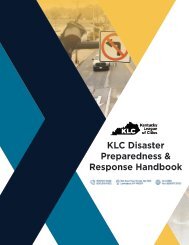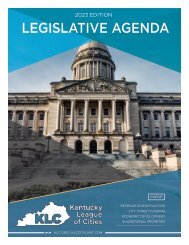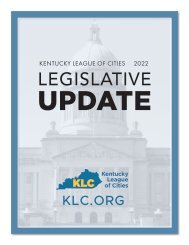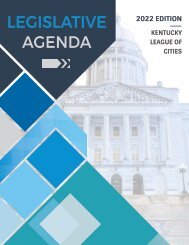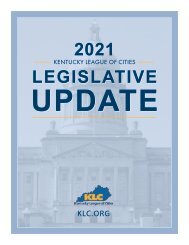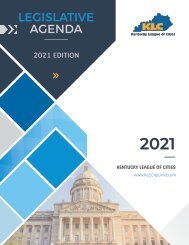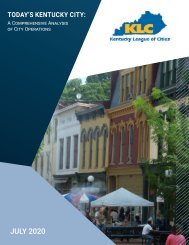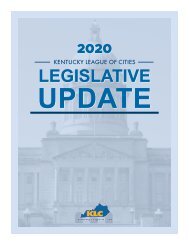KLC 2020 Legislative Agenda
You also want an ePaper? Increase the reach of your titles
YUMPU automatically turns print PDFs into web optimized ePapers that Google loves.
KLC Legislative Agenda 2020
CERS REFORM/SEPARATION
30.00%
25.00%
20.00%
15.00%
Across the state, cities face the mounting cost of a
pension debt that now threatens the future availability of
services residents enjoy and expect. While the legislature
provided a much-needed phase-in of employer
contribution rates in the 2018 session, the pension bill
continues to grow. It is vital to the health of the County
Employees Retirement System (CERS), its employers and
members that the local pension system is put on a path
that ensures investment and management decisions
are based on what is best for CERS. That will require a
separate administration of CERS to ensure its funding
status grows and that the system remains viable for
future generations.
LEGISLATIVE PRIORITY: KLC will advocate for the
affordability of CERS and for separate governance
that is free from political influence and solely focused
on CERS assets and investments to ensure the local
pension system is not unduly affected by decisions
made for the struggling Kentucky Employees
Retirement System (KERS).
From investment strategies to the adoption of
assumption rates, CERS has felt the impact of decisions
that best benefit KERS. The Kentucky Retirement
Systems (KRS) Board of Trustees decided in 2018 to take
a less aggressive approach to investing and move from
equity funds to fixed-income investments.
CERS NONHAZARDOUS
INVESTMENT RETURNS
-Investment Returns
-30-Year Average
10.00%
i!..!.;--...... -,-:---t"r:-i
5.00%
0.00% .Jl-l+lU+Lllf.l-l+l'-'+--+'-'J.l""t'-'t'-'l"-1-t,,.+-"'t""",,.tw-+-+
-5.00%
-10.00%
-15.00%
-20.00%
Fiscal Year
Information KRS provided to the Public Pension
Oversight Board (PPOB) in June 2019 highlighted the
impact that decision has had on CERS. Investment
income earned by the CERS nonhazardous pension
system was one-quarter the amount earned in the same
period for the prior fiscal year.
KRS leadership argues its systems are too poorly funded
to take risks, but CERS is funded at 50.45 percent after
changes made to the mortality rate assumption in
April 2019. It is KERS that is funded at 13.66 percent and
is considered the worst-funded pension system in
America. KRS Executive Director David Eager has testified
that the Kentucky Teachers' Retirement System (KTRS)
sees much better investment returns than KRS because it
is "not in as bad of a shape as KERS" and can invest more
aggressively. However, KTRS is currently funded at 57.7
percent, and it uses drastically different assumption rates
than those adopted for CERS.
INVESTMENT RETURN ASSUMPTIONS FOR
STATE RETIREMENT PLANS NATIONWIDE
8.50%
8.00%
7.25%
7.50%
,...,
6.50% •
I+- CERS, KERS HZ: 6.25%
6.00%
5.50% t
KERS NH, SPRS: 5.25%
1.00% l ,, ___ _
5.00%
♦ Assumed Rate for Each Plan
Pension Plan
-National Median
------- .,..--
ti +ttttH+t -tttttl tttH +++t++Ht tttH
Source: National Association of State Retirement Administrators, 2019
In 2017, the KRS Board of Trustees moved the CERS
assumed rate of return to 6.25 percent. It remains the
second lowest rate in the nation outside of the KERS
nonhazardous pension plan and the Kentucky State
Police Retirement System (SPRS), which are overseen by
the same KRS Board of Trustees. Since that change was
adopted, KRS has reported a 10-year investment rate of
return for CERS of 8.9 percent and a 30-year return of
8.6 percent.
PAGE 3 OF 14





